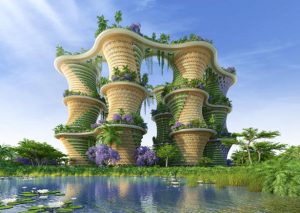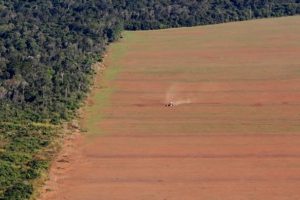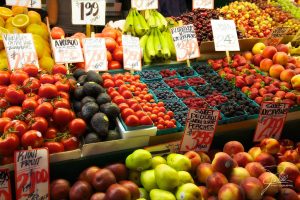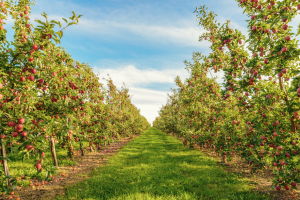Food Towers

Just as we can make towers to clean up the air, we can also make towers to grow fruits and vegetables. The process is called vertical farming, and can be simplified as stacking one greenhouse over another.
Vertical farm designs are becoming popular on the Internet, and you can learn much about them with a few simple searches. Some of these futuristic designs are absolutely beautiful.
One of the most popular models is called the “Urban Skyfarm by Aprill”. This model features a vertical stacking of 60 to 70 decks, and its design resembles a massive tree. This model balances urban development with ecology.
The vegetation inside the vertical farm isn’t only used as food supply, but also serves to convert carbon dioxide into oxygen. The farm comes with solar panels to power the entire system, and there are plans to build one in Seoul, Korea.
Vertical farming is a clear need for our future. The potential benefits include an increased year-round crop production in non-tropical regions. These crops would be protected against most weather related problems, because they would be grown inside a controlled environment. The nature of vertical farming is also helpful for organic crop production. The controlled growing conditions allow for a reduction, and potential abandonment, of the use of chemical pesticides such as glyphosate.
Another benefit is that vertical farming technology tends to include hydroponics, which use 70% less water than normal agriculture. Aeroponics, which can also be used for vertical farming, use less than 90% of the water than normal agriculture.
On top of that (no pun intended), the use of vertical farming can optimize the recycling and composting of urban food waste, and use it for farming inside the building. Sewage sludge can also be converted and transformed into topsoil, and even processed to become drinking water.
Vertical farming is environmentally friendly, reducing our need for land by 100 times or more. That means that with worldwide applications of vertical farms, we could produce more than 100 times the amount of food we are producing today with modern approaches. In other words, we could potentially feed billions of people with this improved technology.
Growing crops indoor can reduce and even eliminate the use of mechanical plows and other equipment. This, in term, reduces burning of fossil fuel, allowing for a significant reduction in air pollution and CO2 emission.
Vertical farms also favor diversity by reducing land disturbance. This allows for wild animals to remain in their natural habitats.
Food towers add another benefit in terms of safety for their workers, given that indoor farms reduce the occupational hazards associated with traditional, horizontal farming. Such risks include accidents in handling farming equipment, exposure to infectious diseases like malaria, exposure to poisonous chemicals, and confrontations with poisonous or dangerous animals.
The ability to sell the crops in the same building where they are grown allows for a reduction in expenses associated with food transportation. It would also provide fresher products, that get to the consumer faster. (1)
Additional benefits in energy use include the use of high efficiency LED lighting technology. These ensure minimum power usage for maximum plant growth. This means that crops don’t need direct sunlight to grow.
Labor needs are also minimal, as vertical farms can become fully automated growing systems with automatic SMS text messaging for any faults. Manual labor is only required on-site for planting, harvesting, and packaging of crops, and the required skill levels are very low.
Vertical farms also allow for a wide range of crops that are able to grow in these systems. The optimal growing conditions can simply be adjusted. (2)
Of course, there are some potential disadvantages and concerns associated with vertical farming. One of them being pollination, which in nature happens through animals and insects, but may need to be done manually in vertical farms. Initial costs are also a concern, since urban land is more expensive than farm land. Building a 30+ story tall building isn’t cheap either, and the mining materials for its construction has huge environmental disadvantages.
That being said, there is no doubt that vertical farms are a possible and profitable option for food farming. In fact, Japan is currently leading the way with hundreds of vertical farms that are currently in operation. Countries like South Korea, Singapore, Taiwan and China are joining the lead. The United States is slowly catching up, with Chicago being one of the first movers in the industry, hosting more than 50 profitable operations in the city.
The city of New York is also moving on the same direction. There are plans in place to build a 70,000 square foot facility, that will produce more than two million pounds of food per year. The construction started in 2015 and is being built by AeroFarms, one of the leading companies in the global industry. (3)
Some good books on food towers include “Vertical Farming” by Dr. Dickson Despommier, and “Plant Factory” by Toyoki Kozai.
Previous Section:
Next Section:
Acknowledgments
Thank you for reading!
Please donate to help us publish this book.
PayPal: trevesbruno@gmail.com
Venmo: @Bruno-Treves
Sources:
(1) http://www.cropsreview.com/vertical-farms.html
(2) http://www.verticalfarms.com.au/advantages-vertical-farming
(3) http://www.dailymail.co.uk/sciencetech/article-3629690/New-York-world-s-biggest-vertical-farm-Giant-70-000-sq-lettuce-factory-produce-2-MILLION-pounds-food-year.html



